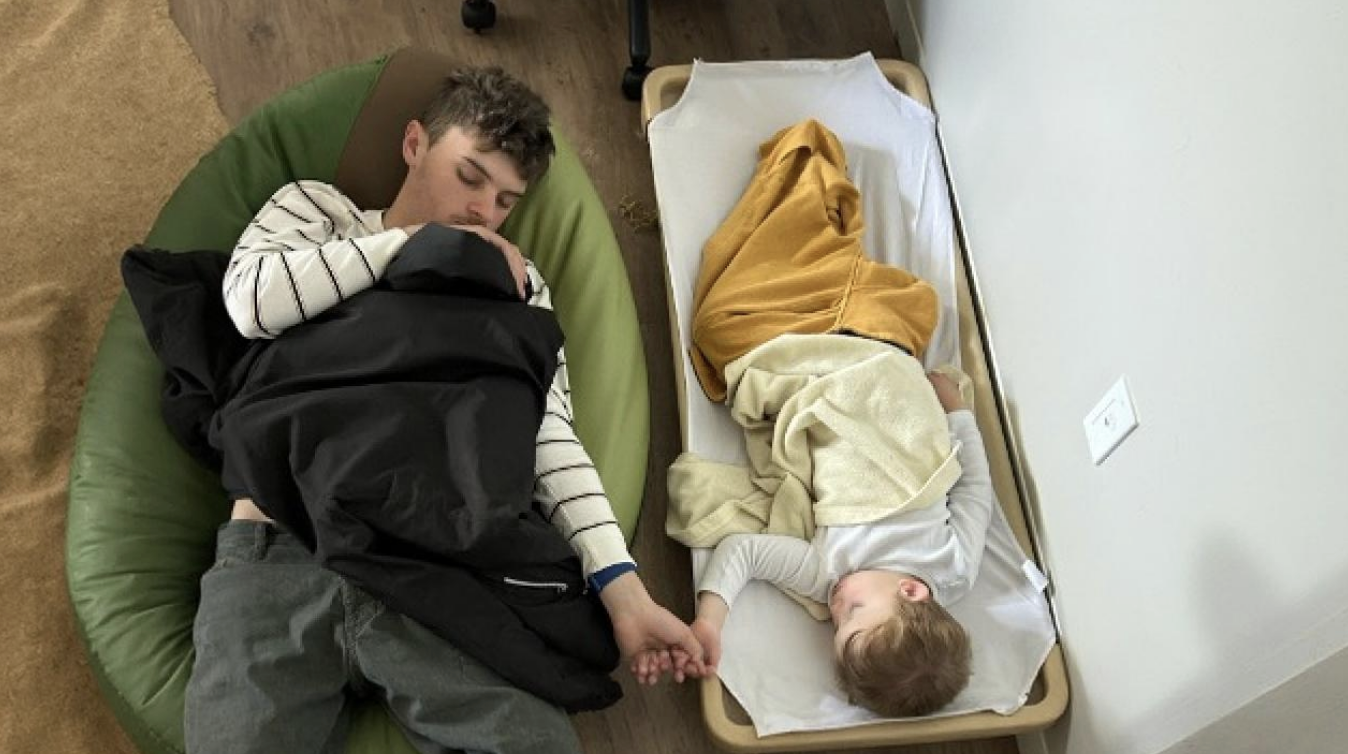Dominique Germain
Department Coordinator, Early Childhood Education
Collège Montmorency, Laval
“In 2020, some people say that men shouldn’t work with children.”
“What’s difficult for me on a day-to-day basis is when I’m told that I supervise the children like a man, and that I should act more like a mother…”
“People say they want men in children’s services, but they want them to act like women.”
“There was one parent who told my principal that they didn’t want me
changing their child’s diaper.”
“My female colleagues in education told me that men shouldn’t care for babies.”
“Sometimes, I worry about people thinking I’m a pedophile when I say I’m an ECE.”
These comments are from Quebec-based early childhood educators who were talking in an online support group about why, in 2020, there are still so few men in the field of early childhood education. Some people may find them overblown or unrealistic, but they are the thoughts of men who are passionate about working with children and who are trying, with mixed success, to create a space for themselves in society’s collective view of early childhood educators. This article will examine gender diversity in the field of early childhood education, a topic of vital importance in a modern society, especially one that claims be forward-looking and strives for equality. When men work with children, it promotes the breaking down of barriers between social roles, and offers proof that anyone can work in a “traditionally gendered” job.
As a professor in early childhood education at Collège Montmorency for a number of years, I have been witness to and recipient of a wide variety of comments on this topic. Some of these comments have been very positive, even very encouraging, about the role of men in the field, while others have been derisive, condescending, discouraging and unacceptable. These comments led me to reflect on the “real” place of men in the field of early childhood education, to identify the difficulties faced by these men, who I refer to as “courageous”, and to research information, from here and other parts of the world, so as to better understand this subject and, ultimately, to do my part to help advance the cause of gender diversity.
” Men need to get more involved in children’s education, and women need to make more space for men and accept them as they are”
Sources on the discussion of men in child care
Many authors, researchers, and others involved in the field of education have considered the question of gender diversity in the education world. My quest for information led me to consult many of these sources, both from here and from other parts of the world. I will discuss the ones that seemed the most relevant to me, along with my comments.
The field of early childhood education… a single-sex world that is slow to change
The research paper by Diren and Besnard (Diren & Besnard, 2009), presented in 2009 as part of a PAREA[1] project, paints an exhaustive picture of the various ways specific groups perceive the place of men in preschool services. The authors conducted their research among current and future CEGEP students and graduates in Early Childhood Education (ECE), instructors in the field, managers of Quebec childcare centres, and early childhood educators. The perspectives presented in the report are interesting, surprising, and revealing, but the conclusions that can be drawn from it are somewhat mitigated. One thing is certain in reading it: the world of early childhood education is far from being a co-ed space. According to the report’s authors, it is easy to conclude that “…the Quebec child-care sector is single-parent, the male presence being notably absent, and this is true in every area, whether in terms of the number of students, teachers, or workers!” (Diren & Besnard, 2009, p. 15).
The Diren and Besnard paper raises two important questions that many people wonder about:
- Should the idea of men working with young children be encouraged?
- Why are so few men found in ECE training programs and the ECE profession?
It is easy to answer the first question in the affirmative, especially if you work in the field of education and care about social progress. The second question requires deeper consideration, and leads to a wider range of hypotheses. The authors identify four answers to this question: low compensation for teachers, flawed recruitment strategies, drawbacks experienced by men in the field, and lack of awareness of the specific contributions men make to children’s development (Diren & Besnard, 2009). These answers led me to wonder whether the situation is an encouraging one for men who want to work in early childhood education, and what could be done to encourage them more.
Early childhood educators: A second mother?
Nicolas Murcier, a French researcher and ECE instructor at the Institut régional de travail social (IRTS) in Poitiers, explains in his article Le loup dans la bergerie (Murcier, 2005), that the field of childcare and children’s education is still women’s work, in spite of societal advances. “In effect, professional practices in early childhood occupations still rely on a replication of the maternal experience and the ‘sacralization’ of the mother’s role in children’s development” (Murcier, 2005, p. 67). He believes that nursery school work is still defined on the basis of gendered tasks rooted in motherhood. He adds that, “…even though the children themselves are obviously of both sexes, childcare and early childhood education still fall within a single-sex, female, framework” (Murcier, 2005, p. 68), which is not representative of society. The positive image of the woman and mother as the one who provides childcare is also the image expected in childcare centres, which unfortunately eclipses the skills that must be acquired to become an early childhood educator of either sex, and makes it difficult for men to access these occupations. German psychologist, researcher, and author Tim Rohrmann (Rohrmann, 2014), explains that the debate in the 90s in Germany concluded that boys were the ones who lost out in education, because they were educated by women. “Early childhood education centres are an area where segregation of the sexes traditionally remains significant,” (Rohrmann, 2014, p. 107). Mike Marchal, president of the Association pour la mixité et l’égalité en petite enfance (AMEPE) seems to be of the same opinion. His trajectory through the world of early childhood education led him to understand that this field, which he chose out of his passion for the work, was a space of “relegation,” “…that is, a professional sector with little social capital, and which primarily women are guided toward or turn to” (Marchal, 2015, p. 3). “Rooted in a maternal model, performed by women, these occupations resemble an extension of the mother’s role in the public sphere” (Marchal, 2015, p. 3). The history of nursery schools in France, which were thought of as “surrogate motherhood” environments, where women were considered second mothers for the babies, is in part responsible for this (Marchal, 2015).
Male educators: The resident handyman!
During his time in the field of childcare and children’s education, Marchal (2015) felt that the people around him watched him more for the fact that he was a man than for his professional capacities or even his personality (Marchal, 2015). On the one hand, his female colleagues considered him the nursery school’s resident handyman, to do repairs or move heavy objects, or when it came to being firm and exercising authority with the children; on the other hand, they doubted his skills at providing support to a mother and her child as they were going through a difficult experience. For Murcier, when men entered this field, it required redefining everyone’s roles, and engaging in “real” reflection for dividing non-gendered tasks (Murcier, 2005). Rohrmann also addresses this issue of tasks being divided between men and women in a stereotypical way, and takes his thoughts on stereotypes a little further, as they often seem to be reinforced by the behaviour of male professionals and the expectations of women, which are sometimes contradictory (Rohrmann, 2014). He argues that studies have shown that the pedagogical activities of educators often tend toward stereotypical behaviour. As Marchal also mentions, it is often expected of men to take care of physical or technical work, and to oversee sports such as soccer, “…but for them to behave with equality toward their female colleagues, and to convey a broadened image of masculinity to the children” (Rohrmann, 2014, p. 112). For men who are trying to find their place in the field, these expectations cause some confusion. Male educators either “…showcase their virility through areas of activity that seem to require abilities that are traditionally conceived of as more male, or develop a professional competency that emphasizes professionalism and masculine relaxedness” (Rohrmann, 2014, p. 113). A balance that seems to be hard to find…
Male and female educators: Different but equal?
Diren and Besnard (2009) also talk about stereotypes when they report that studies show differences between male and female educators. According to two studies, from more than 20 years apart, male educators are apparently drawn more toward boisterous, physical play, while female educators are bigger advocates of quiet play, and exhibit mothering behaviours (Diren & Besnard, 2009). The (male) students in Early Childhood Education (ECE) that were met with in the course of this research also perceived differences between the men and women working in the field. “The students pointed out in their observations that men are more energetic, more action-oriented, and have a tendency to improvise and maintain a distance from what the child is going through” (Diren & Besnard, 2009, p. 17). One student even said that male educators dramatize situations less and are less stressed than their female counterparts. When describing their ECE instructors, male and female, they say that the men have a different approach in the classroom than the women. In their eyes, the men “…are more dynamic, propose projects; they take a more concrete approach to their teaching” (Diren & Besnard, 2009, p. 70). For their part, ECE instructors of both sexes describe the male students as being more physical in how they run things in placements or classroom settings, and as being more tolerant of the children’s play-fighting than women are. In placements, the male students stand out from the female students through their focus on gross motor skills and outdoor activities. The authors also asked these students about their personal pastimes, in order to get to know them better and draw a more accurate picture. “For all the male students, leisure activities, especially sports, accounted for a significant part of their daily lives” (Diren & Besnard, 2009, p. 63). So it is not surprising that these aptitudes stood out in the classroom and in their placements, and it is reassuring that they seem to be able to be themselves around the children.
Norwegian professor Leif Askland (Askland, 2012) writes, in an article titled Égalité des sexes : recruter des hommes dans les jardins d’enfants, that men have a marked interest in nature and the outdoors, music, digital tools, the arts, and physical education, and that they are more interested in kindergartens with a focus on pedagogical content. He also explains that men are drawn towards forest kindergartens[2]. “This structure seems to attract more men than traditional kindergartens. It’s not usual to see these institutions have more than 30% men on their staff” (Askland, 2012, p. 12). It may be that this nature-based concept, which seems to respond to men’s need to move, would be a good way to attract them to the field. Who knows?
What about communication?
The Swiss guide for early childhood education institutions, titled “Pour des hommes et des femmes dans les équipes éducatives” (ASSAE; CREDE, 2009), discusses the images we form of men and women, or the traits of the two genders. It doesn’t identify differences in the way men and women run their classrooms, but instead talks about each one’s styles of communication. Although it would be easy to think this kind of information encourages reliance on stereotypes, I thought it was important to provide it in a table, summarizing the differences mentioned in the guide, which I thoroughly identify with. In fact, when I first read this information, I immediately had scenes run through my head – snippets of my own professional life in the field.
| Men | Women |
| They have a more competitive communication style. | They have a more cooperative communication style. |
| They like to adopt a position and present arguments. | They prefer to focus on furthering the relationship and exchanging information. |
| They are more direct in their communication, and less concerned about the relationship aspect. | They need to create an aspect of openness in their communication |
| They end discussion when they decide that everything has been said. | They prefer to explore the smallest details of a problem and continue debates at length. |
“It is important to be aware of the different communication styles of the men and women you work with, and to recognize the way in which gender also influences communication” (ASSAE; CREDE, 2009, p. 21). However, although these differences may be found in certain individuals, it is important to be careful in attributing communication styles, as not all men or women have the traits mentioned. In particular, men who work in the education sector don’t always develop with traditional “masculine” characteristics and, often, they will distance themselves from them.
Parents’ reactions
Many texts that cover the role of men in the field of early childhood education address the differing reactions from parents. After all, it’s their children that are being entrusted to these professionals. Diren and Besnard (2009) report that, despite the positive reception of men by the team and the children, negative reactions were seen from some parents, and fears of sexual abuse were sometimes voiced. According to the authors, negative reactions were observed when:
- the parents already had negative feelings about other issues
- the parents were questioning the sexual orientation of the educator or student teacher
- the cultural origin of the parent or parents expects a female presence in children’s education
- the educator or student teacher is responsible for hygiene
Reading these research findings surprised – even shocked – me, especially where the educator’s sexual orientation was mentioned. What business is that of the parents’? Isn’t that personal information? What connection is there between sexual orientation and sexual abuse? The background check done by the police on early childhood education workers doesn’t include a “sexual orientation” component, after all…
Some of the managers the authors met with said it was important to reassure parents when they expressed or exhibited negative reactions. In some cases, they even had to assure them that the man didn’t go into the nursery section, that he wouldn’t change diapers, and that he wouldn’t be alone in the washroom with a student, even when a background check had already been performed. Despite this, the report showed that half of the managers involved said that there should be parity between men and women on the working team (Diren & Besnard, 2009). They also mentioned that when a male presence was part of the working culture of the childhood education centre (more than one man, recognized benefits, etc.), the parents displayed more positive reactions. As for the educators, it was pointed out that they tend to want to establish a relationship of trust with the parents, and meet them halfway in order to reassure them (Diren & Besnard, 2009).
Jan Peeters, director of the Centre d’innovation de la petite enfance VBJK in Belgium, believes that men who work in the field of early childhood education need to be careful to avoid negative reactions from parents. In an article he wrote in 2012 for the magazine Enfants d’Europe, he argues that the image of the educator is fragile and often damaged by the way sexual abuse cases are sensationalized (Peeters, 2012). He says that in the wake of media coverage of a pedophilia case in Amsterdam, he received emails from educators saying that they had been the target of negative reactions from parents and friends. “Their professional identity was called into question: taking care of young children was, apparently, not supposed to be men’s work” (Peeters, 2012, p. 16).
In light of this information, which is not the most encouraging for young men who are interested in getting involved in the early childhood education field, the question becomes how to get men more interested in this profession, and how to keep them in this sector. This is what we will try to shed some light on in the next section.
Gender diversity in early childhood education: a cause that is advancing at a snail’s pace
[1] PAREA is a funding program for research on teaching and learning, backed by the Quebec Ministry of Education and Higher Education.
[2] Forest kindergartens are early childhood education centres where outdoor activities play a central role. Some forest kindergartens hold daily, all-day activities in the woods or mountains.

Fostering and maintaining men’s involvement in the field… but how?
To foster the involvement of men in the field of early childhood education, and to keep them in the profession, a variety of strategies have been suggested from all quarters. But first of all, they need to be persuaded to enroll in higher education in ECE. Here are some of the ideas various authors have proposed.
Let men be themselves…
A general, but nonetheless accurate and useful, picture was painted of male ECE students in the PAREA report by Diren and Besnard (2009). According to the authors, the students covered by the study all had experience with children before enrolling in the program, often in the context of supervising day camps, and felt comfortable working with young children. They all said they were patient and sensitive to the needs of others. Most of them described themselves as active, energetic, and inventive, and said they had a good sense of humour and enjoyed sports and physical activity. They said that others found them reassuring and trustworthy. Knowing this, fostering the involvement of these men in this field means, logically, that we need to give them the chance, space and freedom to be who they are, who they have become through their diverse experiences in society, with all the features that make them authentic beings.
Send the right message to teens…
Diren and Besnard (2009) report that educators believe it would be appropriate to make changes to the image of the male educator presented to high school students, and to put the positive role male educators have on children’s development front and centre. In that respect, CEGEPs in Quebec often use images of men with children, precisely to “suggest” that there is gender diversity in the profession, and often emphasize the need for men in children’s services during recruitment. In Germany, the Ministry for Family Affairs has set up an office that, among other things, handles professional career counselling for boys. In 2005, “Boys’Day[1]” came to be. “This is a particular day of the year when teenage boys (mostly from ages 13 to 16) are invited to spend a day in workplaces, but in a non-traditional sector, such as childcare, social work, or preschool education, sometimes with workshops in the schools” (Rohrmann, 2014, p. 117).
Provide male role models to trainees…
The topic of male role models for students was addressed by Diren and Besnard (2009). During ECE training in CEGEP, students should be in contact with a male role model, according to the authors, as this would allow them to share their perceptions and impressions of the field with another man. On this topic, one graduate who had the opportunity to do a placement with a male educator during his program said, “…I thought it was important to spend time with another male educator. His approach with the children spoke to me much more than a woman’s approach” (Diren & Besnard, 2009, p. 111). This mentorship structure would certainly be a winning approach to keep men in the program and help them succeed on the job market.
The Swiss guide for early childhood education institutions aims to encourage training in this male-male mentorship structure, as male educators appreciate not being the only man on a team of women. Men seem to be more motivated when they have a chance to discuss with other men, even if it only comes up in the context of a conference, training day, or network: “Men consider communication opportunities among themselves to be valuable; these discussions motivated them to stay true to the occupation of childcare professional” (ASSAE; CREDE, 2009, p. 12).
Laying the groundwork for men to join the team…
It is recommended in the Swiss guide that teams properly prepare for men’s arrival, but without putting them in the spotlight, which might intimidate them. To keep men in the profession, male educators must not be viewed as the rivals of female educators, but seen for what they are: co-workers. As for parents, it is recommended to inform them and entertain their perceptions by listening to them. Addressing stereotypes and prejudices right off the bat would be a suitable strategy for avoiding uneasiness and apprehension. The benefits and added value of a gender-diverse team should be highlighted. “By offering a co-ed team, we provide a role model for parents. We demonstrate that both men and women are capable of taking on all responsibilities associated with caring for children” (ASSAE; CREDE, 2009, p. 27).
Showing off the added value of gender-diverse teams…
According to Rohrmann (2014), teams that are made up of both men and women work better than teams that are made up of only women. “Indeed, there are indicators that show that professional satisfaction is especially high in gender-diverse teams in Kitas” (Rohrmann, 2014, p. 114). Rohrmann adds that, in many cases, having a male presence in the classroom encourages fathers to take more interest in their child’s school. He mentions a U.S. study that shows that the low number of men in childcare centres seems to have a direct impact on the lack of involvement by fathers in the centre. “A greater number of qualified male professionals would thus seem to be a necessary precondition for improved participation by fathers” (Rohrmann, 2014, p. 114). So it seems that gender-diverse teams encourage gender diversity in parental responsibilities, which is not insignificant.
Establishing social networks…
Norway offers a good example of steps to take to promote gender diversity: since 1995, the government has taken steps to increase the male presence in childhood education (Askland, 2012). According to Leif Askland, the percentage of men working in the profession has increased every year since a variety of action plans were established. The actions taken included networks being set up in which male involvement in kindergartens was showcased and prized. “Social networks can be considered important for driving the continued involvement of men in kindergartens” (Askland, 2012, p. 12). The men who are part of these networks organize seminars, courses and conferences on the subject, as well as outings and other social events to spend time together. According to Askland (2012), these events are especially important for men who otherwise work only with women.
To implement these strategies and ensure they are successful, the ECE world needs the means, the opportunity, and the people. This is why the Comité québécois pour la mixité en éducation à l’enfance was born.
The Comité québécois pour la mixité en éducation à l’enfance: A project inspired by the European experience

An initiative of Collège Montmorency
At Collège Montmorency, we have taken the step of creating the Comité québécois pour la mixité en éducation à l’enfance, drawing inspiration primarily from the work done by the Association pour la mixité et l’égalité en petite enfance (AMEPE) in France and the group Männer in Kitas[4]in Germany. This project, started by myself and my colleague Alain St-Pierre, both of us ECE professors at Collège Montmorency, and supported by the Office of the Director of Studies, the Communications Office, and the Early Childhood Education Department, seeks to create a network of male early childhood educators so that they can share their thoughts, have discussions, and support each other, as well as promote this much-sought-after gender diversity. Meetings of groups of men will serve to promote gender diversity in the field by providing genuine male examples. To us, it is important that a male presence in this field be promoted primarily by men, for men, in order to encourage their involvement in this captivating profession and prove that men, too, have their place in early childhood education. A group of both male and female students will also be associated with the project, as we believe that they have inexhaustible resources to help us promote gender diversity.
Inspiration from France…
The AMEPE, which has been a source of inspiration for our project, is a French association whose purpose is to “promote gender diversity and professional equality in the ECE sector, and to combat gender stereotypes” (Équipe AMEPE, 2020). This association connects professionals who want to share their thoughts, support each other, and break their isolation, by organizing regular meetings for men in the profession and the women who work with them. AMEPE also makes documentary resources available to people who are interested in the subject. A professional workshop was also organized in 2017, as well as a field trip to Norway to meet with early childhood educators from the group Menn I Barnehagen. A travelling exhibition was also developed, showing positive profiles of men who are invested in the field.
[4] This could be translated as “Men in Daycares”.

…and from Germany
The group Männer in Kitas, whose actions have been a big inspiration for us, was created by the German Ministry for Family Affairs with the goal of carrying out projects to attract young men to early childhood education centres. The group has set up roundtables on sexism, gender diversity workshops, and networks of groups of educators. The author of the article Davantage d’hommes dans les Kitas en Allemagne, who is also a highly active researcher in the field, says that the participants in these support groups attest to the benefits of their encounters. They view it as solidarity. The participants appreciate feeling like “men among men” and being able to discuss amongst themselves. “The work circles for male educators in Kitas are men-only discussion spaces, which makes sense in an environment that is numerically dominated by women, just as there are specific offerings for women in fields dominated by men” (Rohrmann, 2014, p. 119). The working groups are greatly appreciated, because they help men grow, both personally and professionally (Rohrmann, 2014). A real inspiration!

Conclusion
In light of the articles written on the subject of gender diversity in the field of early childhood education and the PAERA report by Diren and Besnard (2009), it seems clear that men working with children is still a subject that’s worthy of attention, and will continue to be so for some time. One thing seems certain: we need to keep promoting gender diversity and spreading the word about it. In 2020, it’s no exaggeration to say that we need to do it all the more. It concerns everyone: the men and women who work in the field, teenagers who are exploring their career options, children who are receiving care in ECE services, and fathers and mothers who are entrusting their children to responsible adults.
Achieving gender diversity in ECE teams will only be possible if everyone does their part: men need to get more involved in children’s education, and women need to make more space for men and accept them as they are. Parents need to trust educators, and ECE service managers need to promote gender diversity and recognize the value of the men on their teams. Teenagers need to explore non-traditional jobs, and guidance counsellors need to help change the mentalities of these young people when they are making career choices. And finally, early childhood educators need to come together and meet with, support, and encourage each other, and ECE teachers, like myself and my colleague Alain, need to create opportunities to do this and to facilitate networking.
This article was written for a graduate school course, under the guidance of Joanne Lehrer (UQO).
References
Askland, L. (2012). Égalité des sexes : recruter des hommes dans les jardins d’enfants. Enfants d’Europe, pp. 12-13.
ASSAE; CREDE. (2009). Pour des femmes et des hommes dans les équipes éducatives – guide à l’usage des structures d’accueil de l’enfance. Zürich, Lausane: Éd. CREDE.
Diren, A., & Besnard, T. (2009). Les hommes en TEE, pour une pluralité des pratiques – Rapport de recherche subventionné par le ministère de l’Éducation du Loisir et du Sport dans le cadre du programme d’aide à la recherche sur l’enseignement et l’apprentissage PAREA. Sherbrooke: Cégep de Sherbrooke – PAREA.
Équipe AMEPE. (June 15, 2020). Retrieved from AMEPE: https://amepe.net/.
Germain, D. (November 2017). Dominique Germain professeur en éducation à l’enfance. Retrieved from Linkedin: https://www.linkedin.com/pulse/mixit%C3%A9-et-%C3%A9galit%C3%A9-en-petite-enfance-est-ce-possible-dominique-germain/.
Marchal, M. (2015, /2). Les institutions d’accueil de la petite enfance en France – Un espace social peu ouvert aux hommes et à légalité des sexes. Mouvements, pp. 97-105.
Ministère des familles, de l’Enfance et des Droits des femmes. (s.d.). Cadre national pour l’accueil du jeune enfant. Paris.
Murcier, N. (2005, n. 80). Le loup dans la bergerie. Recherches et prévisions, pp. 67-75.
Peeters, J. (2012). « Les hommes doivent être prudents ». Enfants d’Europe, pp. 16-17.
Rohrman, T. (2014). Plus d’hommes dans les Kitas, une chance pour l’égalité des sexes ? Le furet, pp. 20-21.
Rohrmann, T. (2014). Davantage d’hommes dans les Kitas en Allemagne. ERES Enfance et parentalité, pp. 107-127.












